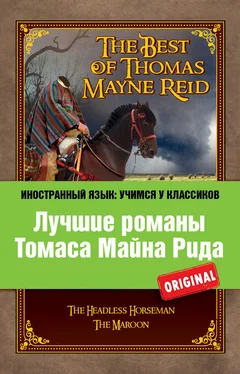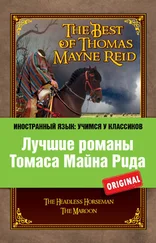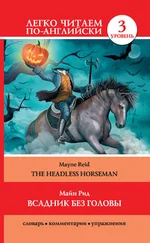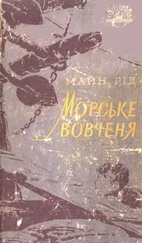Here and there, the lance-like culms of bamboos might be seen shooting up over the tops of the dicotyledons, or forming a fringe along the cliffs above, intermingled with trumpet-trees, with their singular peltate leaves, and tall tree-ferns, whose delicate lace-like fronds formed a netted tracery against the blue background of the sky. In the rich soil of the valley flourished luxuriantly the noble cabbage-palm – the prince of the Jamaica forest – while, by its side, claiming admiration for the massive grandeur of its form, stood the patriarch of West-Indian trees – the grand ceiba ; the hoary Spanish moss that drooped from its spreading branches forming an appropriate beard for this venerable giant.
Every tree had its parasites – not a single species, but in hundreds, and of as many grotesque shapes; some twining around the trunks and boughs like huge snakes or cables – some seated upon the limbs or in the forking of the branches; and others hanging suspended from the topmost twigs, like streamers from the rigging of a ship. Many of these, trailing from tree to tree, were loaded with clusters of the most brilliant flowers, thus uniting the forest into one continuous arbour.
Close under the cliff, and near where the cascade came tumbling down from the rocks, stood a tree that deserves particular mention. It was a ceiba of enormous dimensions, with a buttressed trunk, that covered a surface of more than fifty feet in diameter. Its vast bole, rising nearly to the brow of the cliff, extended horizontally over an area on which five hundred men could have conveniently encamped; while the profuse growth of Spanish moss clustering upon its branches, rather than its own sparse foliage, would have shaded them from the sun, completely shutting out the view overhead.
Not from any of these circumstances was the tree distinguished from others of its kind frequently met with in the mountain forests of Jamaica. What rendered it distinct from those around was, that between two of the great spurs extending outwards from its trunk, an object appeared which indicated the presence of man.
This object was a hut constructed in the most simple fashion – having for its side walls the plate-like buttresses already mentioned, while in front a stockade of bamboo stems completed the inclosure. In the centre of the stockade a narrow space had been left open for the entrance – which could be closed, when occasion required, by a door of split bamboos that hung lightly upon its hinges of withe.
In front, the roof trended downward from the main trunk of the tree – following the slope of the spurs to a height of some six feet from the ground. Its construction was of the simplest kind – being only a few poles laid transversely, and over these a thatch of the long pinnate leaves of the cabbage-palm.
The hut inside was of triangular shape, and of no inconsiderable size – since the converging spurs forming its side walls extended full twelve feet outwards from the tree. No doubt it was large enough for whoever occupied it; and the platform of bamboo canes, intended as a bedstead, from its narrowness showed that only one person was accustomed to pass the night under the shelter of its roof.
That this person was a man could be told by the presence of some articles of male attire lying upon this rude couch – where also lay a strip of coarse rush matting, and an old, tattered blanket – evidently the sole stock of bedding which the hut contained.
The furniture was scanty as simple. The cane platform already mentioned appeared to do duty also as a table and chair; and, with the exception of an old tin kettle, some calabash bowls and platters, nothing else could be seen that might be termed an “utensil.”
There were articles, however, of a different character, and plenty of them; but these were neither simple nor their uses easily understood.
Against the walls hung a variety of singular objects – some of them of ludicrous and some of horrid aspect. Among the latter could be observed the skin of the dreaded galliwasp; the two-headed snake; the skull and tusks of a savage boar; dried specimens of the ugly gecko lizard; enormous bats, with human-like faces; and other like hideous creatures.
Little bags, suspended from the rafters, contained articles of still more mysterious import. Balls of whitish-coloured clay; the claws of the great-eared owl; parrots’ beaks and feathers; the teeth of cats, alligators, and the native agouti; pieces of rag and broken glass; with a score of like odds and ends, forming a medley as miscellaneous as unintelligible.
In one corner was a wicker basket – the cutacoo – filled with roots and plants of several different species, among which might be identified the dangerous dumb-cane; the savanna flower; and other “simples” of a suspicious character.
Entering this hut, and observing the singular collection of specimens which it contained, a stranger to the Island of Jamaica would have been puzzled to explain their presence and purpose. Not so, one acquainted with the forms of the serpent worship of Ethiopia – the creed of the Coromantees. The grotesque objects were but symbols of the African fetish . The hut was a temple of Obi: in plainer terms, the dwelling of an Obeah-man .
Chapter 20
Chakra, the Myal-Man
The sun was just going down to his bed in the blue Caribbean, and tinting with a carmine-coloured light the glistening surface of the Jumbé Rock, when a human figure was seen ascending the mountain path that led to that noted summit.
Notwithstanding the gloom of the indigenous forest – every moment becoming more obscure under the fast-deepening twilight – it could be easily seen that the figure was that of a woman; while the buff complexion of her face and naked throat, of her gloveless hands, and shoeless and stockingless feet and ankles, proclaimed her a woman of colour – a mulatta.
Her costume was in keeping with her caste. A frock of cotton print of flaunting pattern, half-open at the breast: a toque of Madras kerchief of gaudy hues – these were all she wore, excepting the chemise of scarcely white calico, whose embroidered border showed through the opening of her dress.
She was a woman of large form, and bold, passionate physiognomy; possessing a countenance not altogether unlovely, though lacking in delicacy of feature – its beauty, such as it was, being of a purely sensual character.
Whatever errand she was on, both her step and glance bespoke courageous resolve. It argued courage – her being upon the “Mountain,” and so near the Jumbé Rock, at that unusual hour.
But there are passions stronger than fear. Even the terror of the supernatural fades from the heart that is benighted with love, or wrung by jealousy. Perhaps this lone wanderer of the forest path was the victim of one or the other?
A certain expression of nervous anxiety – at times becoming more anguished – would have argued the latter to be the passion which was uppermost in her mind. Love should have looked more gentle and hopeful.
Though it was evident that her errand was not one of ordinary business, there was nothing about her to betray its exact purpose. A basket of palm wickerwork, suspended over her wrist, appeared to be filled with provisions: the half-closed lid permitting to be seen inside a congeries of yams, plantains, tomatoes, and capsicums; while the legs of a guinea-fowl protruded from the opening.
This might have argued a certain purpose – an errand to market; but the unusual hour, the direction taken, and, above all, the air and bearing of the mulatta, as she strode up the mountain path, forbade the supposition that she was going to market. The Jumbé Rock was not a likely place to find sale for a basket of provisions.
After all, she was not bound thither. On arriving within sight of the summit, she paused upon the path; and, after looking around for a minute or two – as if making a reconnoissance – she faced to the left, and advanced diagonally across the flank of the mountain.
Читать дальше
Конец ознакомительного отрывка
Купить книгу











